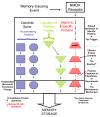Altered protein synthesis is a trigger for long-term memory formation
- PMID: 17919940
- PMCID: PMC2323606
- DOI: 10.1016/j.nlm.2007.08.009
Altered protein synthesis is a trigger for long-term memory formation
Abstract
There is ongoing debate concerning whether new protein synthesis is necessary for, or even contributes to, memory formation and storage. This review summarizes a contemporary model proposing a role for altered protein synthesis in memory formation and its subsequent stabilization. One defining aspect of the model is that altered protein synthesis serves as a trigger for memory consolidation. Thus, we propose that specific alterations in the pattern of neuronal protein translation serve as an initial event in long-term memory formation. These specific alterations in protein readout result in the formation of a protein complex that then serves as a nidus for subsequent perpetuating reinforcement by a positive feedback mechanism. The model proposes this scenario as a minimal but requisite component for long-term memory formation. Our description specifies three aspects of prevailing scenarios for the role of altered protein synthesis in memory that we feel will help clarify what, precisely, is typically proposed as the role for protein translation in memory formation. First, that a relatively short initial time window exists wherein specific alterations in the pattern of proteins translated (not overall protein synthesis) is involved in initializing the engram. Second, that a self-perpetuating positive feedback mechanism maintains the altered pattern of protein expression (synthesis or recruitment) locally. Third, that other than the formation and subsequent perpetuation of the unique initializing proteins, ongoing constitutive protein synthesis is all that is minimally necessary for formation and maintenance of the engram. We feel that a clear delineation of these three principles will assist in interpreting the available experimental data, and propose that the available data are consistent with a role for protein synthesis in memory.
Figures



References
-
- Abel T, Martin KC, Bartsch D, Kandel ER. Memory suppressor genes: inhibitory constraints on the storage of long-term memory. Science. 1998;279:338–41. - PubMed
-
- Agranoff BW, Davis RE, Brink JJ. Chemical studies on memory fixation in goldfish. Brain Res. 1966;1:303–9. - PubMed
-
- Barondes SH. Cerebral protein synthesis inhibitors block long-term memory. Int Rev Neurobiol. 1970;12:177–205. - PubMed
Publication types
MeSH terms
Substances
Grants and funding
- P30 NS047466/NS/NINDS NIH HHS/United States
- P30 NS057098/NS/NINDS NIH HHS/United States
- R01 NS034007/NS/NINDS NIH HHS/United States
- MH57014/MH/NIMH NIH HHS/United States
- R01 NS047384/NS/NINDS NIH HHS/United States
- NS047384/NS/NINDS NIH HHS/United States
- R01 NS013546/NS/NINDS NIH HHS/United States
- R29 NS034007/NS/NINDS NIH HHS/United States
- NS057098/NS/NINDS NIH HHS/United States
- R01 MH057014/MH/NIMH NIH HHS/United States
- NS034007/NS/NINDS NIH HHS/United States
- NS047466/NS/NINDS NIH HHS/United States
- NS13546/NS/NINDS NIH HHS/United States
- R37 NS034007/NS/NINDS NIH HHS/United States
LinkOut - more resources
Full Text Sources
Medical

